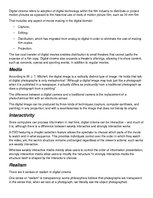-
Digital Cinema
A fourth sense of realism is illusionism. It is sometimes claimed that the cinema spectator is under an illusion, understood as a false belief, such as thinking that they are in the presence of the events presented. For instance, the viewer may believe that they are seeing an image of an actor moving in a real area, when in fact the scene was produced entirely digitally.
A fifth sense of “realism,” is photorealism. It uses a photograph as the standard of reality and tries to make the animated image look like a photograph. It can be achieved comparatively easily in digital cinema, unlike traditional film. An animation image is photoreal when it looks like a photograph of a real object. Photoreal animation is a central means for achieving the realism of fantasy and special effects digital movies.
Finally, there is epistemic realism: An image is true if it contains strong proof that what it claims to show actually occurred. We consider a photograph as much greater evidence for something having happened than we would a drawing or painting of the same subject. As a result, digital cinema has more capabilities than traditional film in terms of generating realistic-looking visuals.
In general, the introduction of digital cinema has improved filmmakers' opportunities to convey what has previously been impossible to portray, as well as opportunities for amateur and low-budget filmmakers.
…


